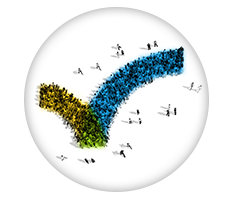How to Start Using Buying Groups

In our last blog (B2B Buying Groups: What You Should Know), we discussed the importance of marketing to buying groups to help drive your bottom line. Simply put, understanding the group-buying dynamic can revolutionize the way your company goes to market.
The question then becomes: How do I do it? How do I go about creating a marketing campaign or program leveraging buying groups?
Based on our experience, effective buying group marketing takes place in five steps:
#1. Identify Which Personas are Likely to be Involved in the Buying Group for Your Solution(s)
Imagine that a company is in the market for a SaaS solution to store and share files that current live in its on-site servers.
Within that company, there are numerous groups who see the need to move away from their existing set-up. For the finance department, it is a matter of saving money. For the security team, the need is around increasing data privacy and security. The IT group is concerned about efficiency and eliminating the maintenance of on-site hardware. There would also be impacts to compliance departments, especially in a regulated industry.
Each of these groups are going to have different concerns about – and needs for – the new solution. To be able to efficiently market your solution (or solutions), you need to understand who is at the table.
#2. Be Sure You Know the People Who Match Your Personas
Once you define which job roles should be included in your buying group models, you need to attach those personas to business contacts in your target accounts.
If you don’t have that ability in house, call us at Anteriad. We can get that information for you.
#3. Match Your Personas with Buyer Roles
To truly understand how B2B purchase decisions are made, you need to know not only who is in the buying group but also how these individuals interact.
Some buying group members are pushing hard for organizational change; others just want details on your specifics about your solution. Within buying groups there are generally five roles:
Champion
These people tend to be engaged throughout the buying process. They are often in a mid-level managerial role and see the need for a new solution to improve efficiency or tackle new opportunities on a day-to-day basis.
Influencer
Influencers tend to pop in and out of the purchase journey, to provide expertise or conduct additional research. It’s important to engage influencers at the top of your pipeline with educational materials, and stay connected during the solution evaluation and selection process.
Decision maker
In enterprise B2B, these tend to be heads of the department that holds the budget. These prospects come into the buying journey when it’s time to commit to budget, and again when it’s time to pick a solution.
User
In a committee purchase scenario, users often come from LOB teams and get involved very early in the process.
Ratifier
These folks sign the checks. They tend to simply follow the guidance of the buying group, and just need an offer of a case study or other confidence-builder toward the end of the purchase.
#4. Build your Buying Group Purchase Journey Map
After you identify the buyer roles that you are going to associate with your personas, you map them out across the phases of the buyer group purchase journey:
Care
- Evaluating the current state
- Committing to change
Consider
- Exploring possible solutions
- Weighing pros and cons
Choose
- Justifying the decision
- Choosing a solution
Think about who will be involved in each stage and map them to the corresponding stage. Keep in mind that most roles will be involved in multiple stages.
#5. Monitor, Adjust and Target
With your buying group framework in hand, you can target individual personas based on their buyer role, as well as their formal stake in the purchase process.
As with all data-driven sales and marketing strategies, it’s vital to identify exactly when your prospects are expressing interest (intent signal monitoring is a useful tool here). For example, no matter how badly they may want to, your champion may not be the person to sign that check.
Using intent data, you can not only identify which personas are researching your solution, you can also identify when those contacts are progressing through the buyer’s journey and how their buyer role may be changing. Conversely, you can also glean insights as to where contacts are falling out of your journey.
Next Steps
Conceptually, buying group marketing represents a new way of going. By taking a more holistic approach, marketers can create and deliver more tangible messages to the people who are making the decisions, within the context of their role in the buying process.
Remember, making the shift to buying group marketing doesn’t happen overnight. Give yourself (and your team) the space to iterate, measure, and expand your approach over time. By following the five steps above and putting the focus on the needs of your prospects and customers, the results will come.
To learn more about marketing to buying groups, check out the following resources:
- B2B Buying Groups: What You Should Know
- How Buying Groups Can Accelerate Momentum
- Moving from ABM Engagement to Enablement by Leveraging Buying Groups
This blog about getting started with buying groups.

